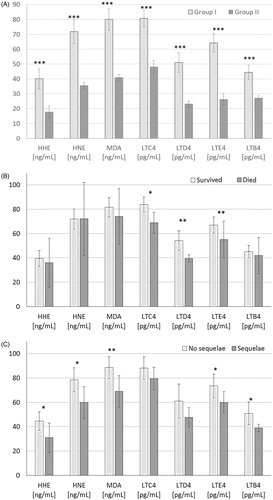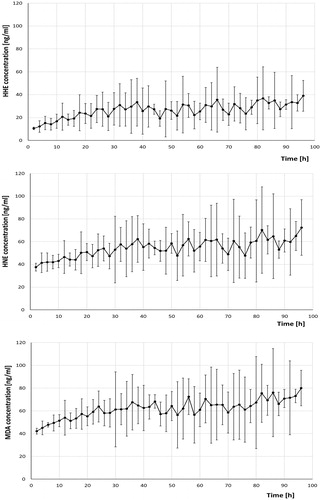Figures & data
Table 1. Demographic and admission laboratory data in the patients with acute serum lipid oxidative damage markers measurements (Group I, acute) and in the follow-up group of survivors 2 years after discharge from hospital (Group II, follow-up).
Figure 1. Box-and-whisker plots of concentrations of serum lipid oxidative damage markers measured during hospitalization and at follow-up. Acute Cmax; maximum serum concentrations measured during hospitalization. Mean, standard error of the mean (SEM, box) and 95%CI of the mean (whiskers) are presented. All p < .001.

Figure 2. Serum lipid oxidative damage markers and leukotrienes concentrations measured during hospitalization and in the follow up group of survivors 2 years after discharge (A), in the survivors versus the patients who died during hospitalization (B), and in the survivors with sequelae versus survivors without sequelae (C), means ± 95%CI. LTB4, LTC4, LTD4, LTE4: cysteinyl-leukotrienes LTB4, BLTC4, LTD4, LTE4; HHE: 4-hydroxy-trans-2-hexenal; MDA: malondialdehyde; HNE: 4-hydroxynonenal; No sequelae – the patients in Group I who survived without health sequelae of acute methanol poisoning; Sequelae – the patients in Group I who survived with long-term visual and/or CNS sequelae of acute methanol poisoning; ***p < .001, **p < .01, *p < .05.

Figure 3. Dynamics of concentration changes in acute serum lipid oxidative damage markers during the observation period, in patients hospitalized with acute methanol intoxication.

Table 2. Correlations of acute serum lipid peroxidation markers concentrations and acute serum LTs concentrations.
Figure 4. Decreases in concentrations of serum lipid oxidative damage markers measured during hospitalization (“Acute”) versus concentrations measured 2 years after discharge, in the same patients (“Follow-up”).

Figure 5. Follow-up serum concentrations of markers of lipid peroxidation and leukotrienes measured 2 years after discharge in survivors without sequelae versus survivors with long-term visual and/or CNS sequelae of poisoning. HHE: 4-hydroxy-trans-2-hexenal; MDA: malondialdehyde; HNE: 4-hydroxynonenal; LTB4, LTC4, LTD4, LTE4: cysteinyl-leukotrienes LTB4, BLTC4, LTD4, LTE4; No sequelae – the patients in the follow-up Group II survived without health sequelae of acute methanol poisoning; Sequelae – the patients in the follow-up Group II survived with long-term visual and/or CNS sequelae of acute methanol poisoning; p < .05 was considered as significant.

